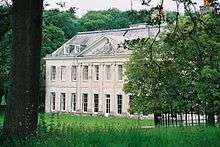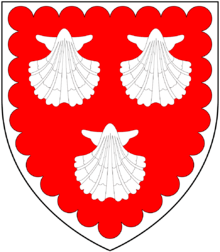Charborough House


Charborough House, also known as Charborough Park, is a grade I listed building,[2] the manor house of the ancient manor of Charborough. The house is situated between the villages of Sturminster Marshall and Bere Regis in Dorset, England. The grounds, which include a deer park and gardens, adjoin the villages of Winterborne Zelston, Newton Peveril and Lytchett Matravers: they are Grade II* listed in the National Register of Historic Parks and Gardens,[3] and have been called the most splendid parkland in Dorset.[4]
History
The estate is listed as a manor in the Doomsday Book of 1086.[5] It was later acquired during the reign of Queen Elizabeth I (1558-1603) by Walter I Erle (c.1520-1581), an officer of the Privy Chamber to King Edward VI and to his sisters Queen Mary I[6] and Queen Elizabeth I.[7] He married Mary Weekes, one of the 5 daughters and co-heiresses of Richard Weekes of Bindon in the parish of Axmouth, Devon.[8] Following the Dissolution of the Monasteries he purchased the manor of Axmouth, formerly a possession of Syon Abbey.[9]
From the Erle family it descended by various female lines to the present owner Richard Drax,[10] the Conservative Member of Parliament for South Dorset since 2010, a member of the quadruple-barrelled surnamed family of Plunkett-Ernle-Erle-Drax. The Erle (alias Earl, Earle, etc.) family originated in east Devon and moved to neighbouring Dorset in about 1500, but died out in the male line on the death of General Thomas III Erle (1650-1720) without male progeny. His daughter and sole heiress Frances Erle (d.1728) married Edward Ernle, to which family the estate passed. Female heiresses subsequently brought the Erle/Ernle estates to various other families.
Mansion House
The surviving mansion house is in the centre of the park and incorporates parts of the original house built by Sir Walter II Erle (1586–1665) (grandson of Walter I), Military Governor of Dorchester and a Parliamentarian commander during the Civil War, whose forces besieged Corfe Castle in 1646. Stone and timber were taken from Corfe for use in the house's construction. He fought for the international Protestant cause as a volunteer in the Dutch army, and was present at the siege of ’s-Hertogenbosch. He was impressed by the Dutch fortifications and on his return home had the garden at Charborough "cut into redoubts and works" as he had seen. He also employed a Dutchman to make a decoy pool for duck shooting.[11]
Estate wall and entrances
Charborough Park is surrounded by one of the longest brick walls in England,[12] comprising more than 2 million bricks and built between 1841 and 1842 by the then owner of the park John Samuel Wanley Sawbridge-Erle-Drax. He succeeded in having the new Wimborne/Dorchester turnpike moved further away from his house, a detour of over half a mile, but unfortunately for Sawbridge-Erle-Drax — who was also its chief promoter and investor — the turnpike lost money, mainly because the railway between Wimborne and Dorchester opened shortly afterwards.
The park wall runs alongside the A31 and is punctuated by Stag Gate at the northern extremity and Lion Lodge at the easternmost entrance, with heraldic symbols in Lithodipyra (Coade stone) created by Eleanor Coade's Artificial Stone Manufactory.[13] These gateways are Grade II listed, as is a third one, East Almer Lodge,[3] further to the west. A fourth gateway, Peacock Lodge, which is inside the current bounds of the estate,[4] is Grade II* listed.[3] The stag on top of 'Stag Gate' appears to have five legs, though one of these is instead an integral 'tree stump' that enhances the strength of the sculpture.[14]
The Drax estate is thought to consist of nearly 7,000 acres (28 km2),[15] and the private grounds are open to the public once or twice a year, when local villagers sell tea and cakes.[16]
Thomas Erle
Thomas Erle c 1650-1720, served as MP for Wareham and a DL for Dorset. In 1686 he hosted a group of conspirators who met at Charborough House to plan the overthrow of "the tyrant race of Stuarts", which resulted in the overthrow of James II of England in 1688 by a union of Parliamentarians and the Dutch stadtholder William III of Orange-Nassau (Prince William of Orange). The meeting was effectively the start of the build-up to the Invitation to William, Prince of Orange, signed by the Immortal Seven, which resulted in the Glorious Revolution of 1688 which overthrew King James II in favour of the Dutch stadtholder Prince William III of Orange-Nassau, subsequently King William III of England.
Erle also served as Lord Justice of Ireland; MP for Cork in the Irish Parliament; Lieutenant-General of the Ordnance in Spain and France; and Governor of Portsmouth.
Parliamentary representation
Family members who served as Members of Parliament for Wareham include:
1679-1698, 1701–1718, Thomas Erle (born c. 1650, died 23 July 1720)
1701, 1704, 1710, 1722 Sir Edward Ernle (born c. 1673, died 31 Jan 1729)
1718, 1734, 1751, Henry Drax (born c. 1693, died 24 May 1755)
1747, 1754, 1761, Thomas Erle Drax (born c. 1721, died December 1789)
1755, Edward Drax (born c. 1726, died April 1791)
1841, 1859, 1868, John Samuel Wanley Sawbridge Erle-Drax (born 6 October 1800, died 7 January 1887);[17]
the current owner, Richard Drax (born 1958), has served as Member of Parliament for South Dorset since 2010.[18]
Further reading
References
- ↑ Pole, Sir William (d.1635), Collections Towards a Description of the County of Devon, Sir John-William de la Pole (ed.), London, 1791, p.481; Sir William Pole (d.1635) of Shute, Devon, author of this work, was the uncle of Col. Sir Walter Erle (1586-1665) of Charborough, the son of his sister Dorothy Pole
- ↑ Historic England. "Charborough Park (1323286)". National Heritage List for England. Retrieved 6 July 2014.
- 1 2 3 Historic England. "Charborough Park (1000713)". National Heritage List for England. Retrieved 6 July 2014.
- 1 2 Newman, John; Pevsner, Nikolaus (1997). The Buildings of England: Dorset. London: Penguin. pp. 139–141. ISBN 0-14-071044-2.
- ↑ Charborough House - Domesday Book
- ↑ Pole, Sir William (d.1635), Collections Towards a Description of the County of Devon, Sir John-William de la Pole (ed.), London, 1791, p.123
- ↑ History of Parliament biography of Walter Erle (1586–1665)
- ↑ Risdon, p.26
- ↑ Risdon, Tristram (d.1640), Survey of Devon, 1811 edition, London, 1811, with 1810 Additions, pp.25-6
- ↑ Biography from Great British Life
- ↑ History of Parliament biography of Walter Erle (1586–1665)
- ↑ www.waymarking.com
- ↑ www.british-history.ac.uk
- ↑ Drakesfamily website Archived 2011-05-04 at the Wayback Machine.
- ↑ Daily Mail article
- ↑ www.parksandgardens.org
- ↑ Burke's History of the Landed Gentry or Commoners of Great Britain and Ireland, 1838
- ↑ www.parliament.uk
Notes
- Burke's Peerage & Baronetage
- John Newman and Nikolaus Pevsner, The buildings of England: Dorset. Harmondsworth: Penguin, 1972, p. 140.
- Letter from Hardy to Bertram Windle, transcribed by Birgit Plietzsch, from CL, vol 2, pp 131-133
- General Thomas Erle at www.janus.lib.cam.ac.uk
External links
| Wikimedia Commons has media related to Charborough House. |